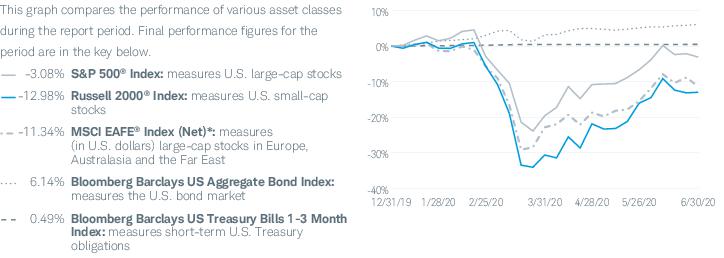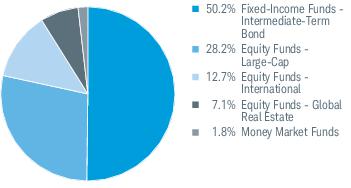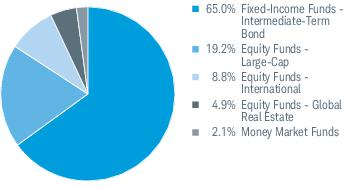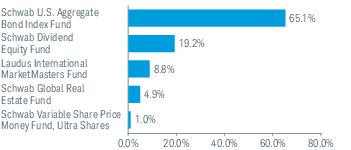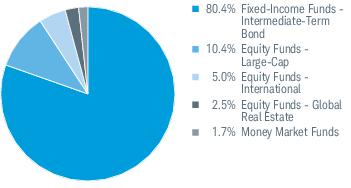3. Risk Factors (continued):
Conflicts of Interest Risk. The investment adviser’s authority to select and substitute underlying funds from a variety of affiliated and unaffiliated mutual funds and ETFs may create a conflict of interest because the fees paid to it and its affiliates by some underlying funds are higher than the fees paid by other underlying funds. The investment adviser also may have an incentive to select an affiliated underlying fund for other reasons, including to increase assets under management or to support new investment strategies. In addition, other conflicts of interest may exist where the best interests of the affiliated underlying fund may not be aligned with those of a fund. However, the investment adviser is a fiduciary to the fund and is legally obligated to act in the fund’s best interests when selecting underlying funds.
Market Risk. Financial markets rise and fall in response to a variety of factors, sometimes rapidly and unpredictably. Markets may be impacted by economic, political, regulatory and other conditions, including economic sanctions and other government actions. In addition, the occurrence of global events, such as war, terrorism, environmental disasters, natural disasters, and epidemics may also negatively affect the financial markets. As with any investment whose performance is tied to these markets, the value of an investment in the fund will fluctuate, which means that an investor could lose money over short or long periods.
Structural Risk. The funds’ monthly income payments will be made from fund assets and will reduce the amount of assets available for investment by the fund. Even if a fund’s capital grows over time, such growth may be insufficient to enable the fund to maintain the amount of its targeted annual payout and targeted monthly income payments. A fund’s investment losses may reduce the amount of future cash income payments an investor will receive from the fund. The dollar amount of a fund’s monthly income payments could vary substantially from one year to the next and over time depending on several factors, including the performance of the financial markets in which the fund invests, the allocation of fund assets across different asset classes and investments, the performance of the fund’s investment strategies, and the amount and timing of prior distributions by the fund. It is also possible for payments to go down substantially from one year to the next and over time depending on the timing of an investor’s investments in the fund. Any redemptions will proportionately reduce the amount of future cash income payments to be received from the fund. There is no guarantee that the fund will make monthly income payments to its shareholders or, if made, that the fund’s monthly income payments to shareholders will remain at a fixed amount.
Direct Investment Risk. The funds may invest directly in cash, cash equivalents and equity and fixed-income securities, including money market securities to maintain their allocations. A fund’s direct investment in these securities is subject to the same or similar risks as an underlying fund’s investment in the same securities.
Underlying Fund Investment Risk. Before investing in the funds, investors should assess the risks associated with the underlying funds in which a fund may invest, which include any combination of the risks described below.
• Investment Risk. The funds may experience losses with respect to their investment in an underlying fund. Further, there is no guarantee that an underlying fund will be able to achieve its objective.
• Management Risk. Certain underlying funds are actively managed mutual funds. An underlying fund’s adviser applies its own investment techniques and risk analyses in making investment decisions for the fund, but there can be no guarantee that they will produce the desired results or cause the underlying fund to meet its objectives.
• Equity Risk. The prices of equity securities rise and fall daily. These price movements may result from factors affecting individual companies, industries or the securities market as a whole. In addition, equity markets tend to move in cycles, which may cause stock prices to fall over short or extended periods of time.
• Market Capitalization Risk. Securities issued by companies of different market capitalizations tend to go in and out of favor based on market and economic conditions. During a period when securities of a particular market capitalization fall behind other types of investments, an underlying fund’s performance could be impacted.
• Concentration Risk. To the extent that an underlying fund’s or the index’s portfolio is concentrated in the securities of issuers in a particular market, industry, group of industries, sector, country or asset class, the underlying fund may be adversely affected by the performance of those securities, may be subject to increased price volatility and may be more vulnerable to adverse economic, market, political, or regulatory occurrences affecting that market, industry, group of industries, sector, country or asset class.
• Fixed Income Risk. Interest rates rise and fall over time, which will affect an underlying fund’s yield and share price. A change in a central bank’s monetary policy or economic conditions, among other things, may result in a change in interest rates. A rise in interest rates could cause an underlying fund’s share price to fall. The credit quality of a portfolio investment could also cause an underlying fund’s share price to fall. An underlying fund could lose money if the issuer or guarantor of a portfolio investment or the counterparty to a derivatives contract fails to make timely principal or interest payments or otherwise honor its obligations. Fixed-income securities may be paid off earlier or later than expected. Either situation could cause an



